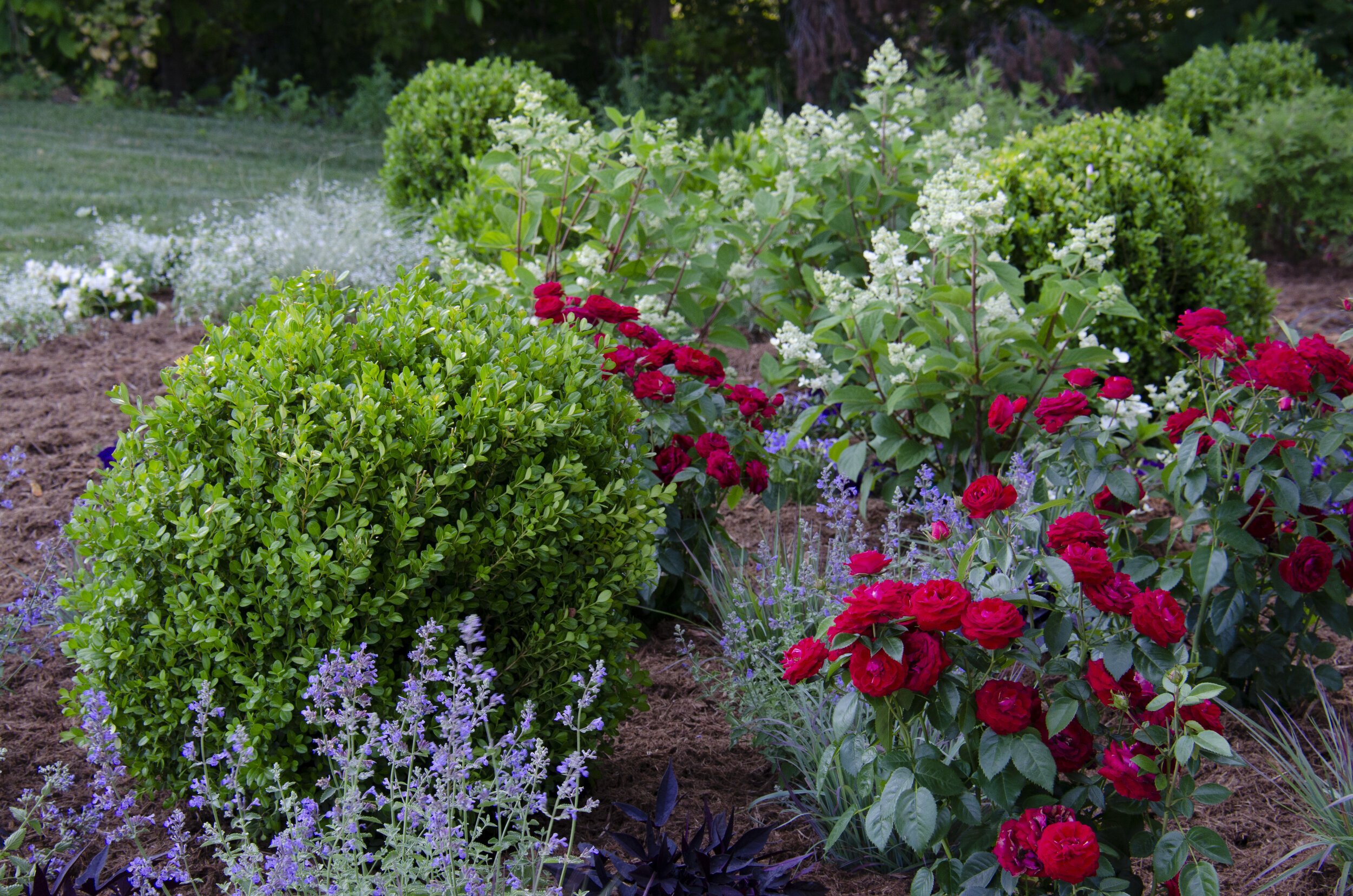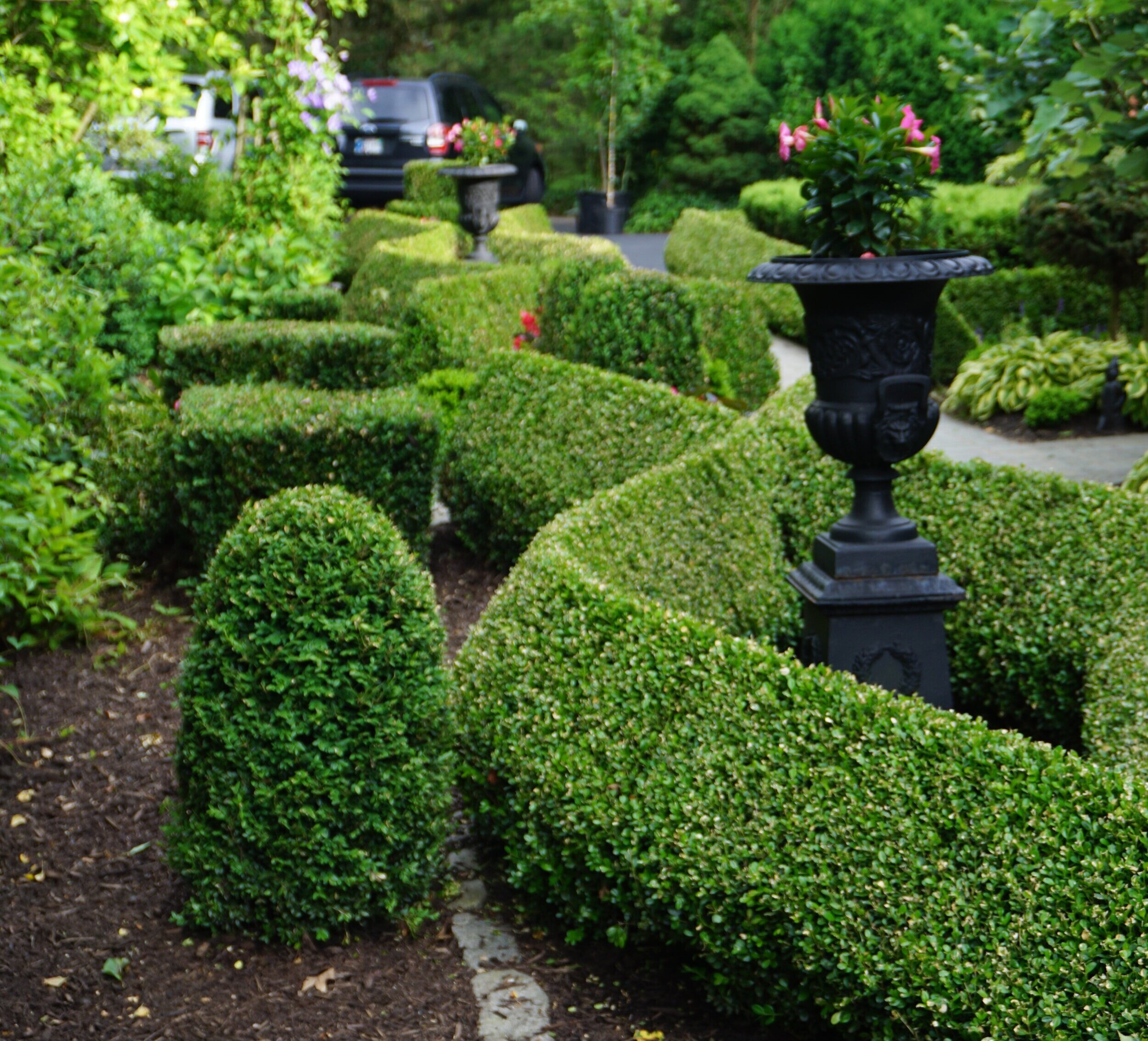NewGen Freedom® mixing with some bright flowers in a perennial bed.
With many people hunkered down at home during the COVID-19 outbreak, everyone is finding ways to de-stress and pass the time while staying healthy. Most nurseries and garden centers remain open as essential businesses and provide many people a safe way to celebrate the season. Nurseries and garden retailers are adapting to ensure customer safety, all while providing the plants and supplies needed to create and maintain at home gardens and landscapes. Spring marks the perfect time to plant many varieties of trees and shrubs, including boxwood. Time to take a break from the news, or binge watching a new show, and spend some time soaking up Vitamin D in the garden!
Boxwood tolerate pruning well and can make beautiful, intricate hedges.
Boxwood offer many benefits to new and established landscapes and are known for their easy maintenance. With few pests and diseases affecting them, most varieties and cultivars require annual pruning and minimal supplemental nutrients. These timeless evergreen shrubs are characterized by their longevity, come in many sizes providing versatile shape and structure to any landscape for ages to come.
Boxwood lining a walkway to a front door.
Though boxwood require minimal care, there are a few things to consider before planting, beginning with site selection.
Start by checking the soil to be sure it provides good drainage. Boxwood, like many plants, don’t enjoy having “wet feet” or their roots are sitting in soil that is regularly saturated with water. Soil with good drainage provides an environment for healthy roots and overall plant growth. Boxwood prefer a soil pH that is more neutral, preferably between 6.5-7.0. If your soil pH is below that, amendments such as dolomitic lime or other fertilizers can be added to raise the pH.
When selecting a site for your boxwood, it is also important to consider sun exposure. Many boxwood prefer some shade, but different varieties and cultivars can handle different exposures. There are many varieties and cultivars of boxwood that offer different shapes, sizes, colors, and even pest and disease resistance! Now that you’ve found the perfect location, it is time to decide which cultivar fits your needs best. Resources such as the Saunders Brothers Boxwood Guide offer lots of information about many of the varieties on the market. There is also detailed information about NewGen Freedom® and NewGen Independece® under the NewGen™ tab on our website.
NewGen Independence® and it’s dark shiny foliage catching the last of the afternoon sun.
Once you’ve selected the proper location and best variety for your landscape, it’s time to plant! Start by digging a hole approximately twice as wide as the root ball, and deep enough that about 2” of the original root ball is above the soil line. This is often referred to as “planting high,” helping with drainage. Make sure the root ball is sitting on undisturbed soil, so that the soil won’t settle and reduce drainage later. See the diagram below.
After planting and covering the root ball, make sure to irrigate well. Many experienced gardeners will tell you the first watering after planting is the most critical! Be sure to fully soak the recently planted boxwood, being diligent that the water soaks all the way through the root ball. Afterwards, periodic watering on an as-needed basis is best. Monitor for adequate moisture, approximately 1” of precipitation or irrigation a week for the first year. For more detailed information about site selection and irrigation, check out the highlighted article.
Boxwood make great hedges around container and vegetable gardens.
Finally, once your new boxwood is planted and watered in, it is time to mulch. Mulching boxwood used to be discouraged, however new research findings have proven that mulching boxwood is an essential part of maintenance. Not only does mulching reduce weeds, regulate soil temperature, and encourage proper soil ecology, it also helps prevent Boxwood Blight. A layer of mulch about 1” thick is sufficient.
Although many may be feeling discouraged as we adapt to life at home for the next few weeks, it is important to look at this as an opportunity to start something new or revitalize an old landscape. Getting your hands dirty with some fresh soil as you add your beautiful new boxwood to your landscape is sure to bring a smile to your face and hope in your heart. Take this time to spruce up your green space with a landscape you will cherish for years to come.
Different cultivars of boxwood can be used together to make elegant designs.







